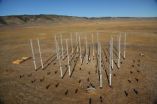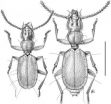(Press-News.org) More carbon dioxide in the atmosphere causes soil to release the potent greenhouse gases methane and nitrous oxide, new research published in this week's edition of Nature reveals. "This feedback to our changing atmosphere means that nature is not as efficient in slowing global warming as we previously thought," said Dr Kees Jan van Groenigen, Research Fellow at the Botany department at the School of Natural Sciences, Trinity College Dublin, and lead author of the study.
Van Groenigen, along with colleagues from Northern Arizona University and the University of Florida, gathered all published research to date from 49 different experiments mostly from North America, Europe and Asia, and conducted in forests, grasslands, wetlands, and agricultural fields, including rice paddies. The common theme in the experiments was that they all measured how extra carbon dioxide in the atmosphere affects how soils take up or release the gases methane and nitrous oxide.
The research team used a statistical technique called meta-analysis, or quantitative data synthesis, a powerful tool for finding general patterns in a sea of conflicting results. "Until now, there was no consensus on this topic, because results varied from one study to the next," explained Professor Craig Osenberg of the University of Florida and co-author of the study. "However, two strong patterns emerged when we analysed all the data: firstly more CO2 boosted soil emissions of nitrous oxide in all the ecosystems, and secondly, in rice paddies and wetlands, extra CO2 caused soils to release more methane." Wetlands and rice fields are two major sources of methane emissions to the atmosphere.
The culprits are specialised microscopic organisms in soil, that respire the chemicals nitrate and carbon dioxide, like humans respire oxygen. The microbes also produce methane, a greenhouse gas 25 times more powerful than carbon dioxide, and nitrous oxide, 300 times more potent than carbon dioxide. Their oxygen-free habit is one of the reasons these microorganisms flourish when atmospheric carbon dioxide concentrations increase. Van Groenigen explained: "The higher CO2 concentrations reduce plant water use, making soils wetter, in turn reducing the availability of oxygen in soil, favoring these microorganisms."
The other reason these microorganisms become more active is that increasing CO2 makes plants grow faster, and the extra plant growth supplies soil microorganisms with extra energy, pumping up their metabolism. This extra plant growth is one of the main ways ecosystems could slow climate change. With more CO2, plants grow more, soaking up carbon dioxide through photosynthesis, and, the hope is that they also lock away carbon in wood and soil. But this new work shows that at least some of that extra carbon also provides fuel to microorganisms whose byproducts, nitrous oxide and methane, end up in the atmosphere and counteract the cooling effects of more plant growth.
"It's an ecological point and counterpoint: the more the plants soak up CO2, the more microbes release these more potent greenhouse gases," said Bruce Hungate, Professor at Northern Arizona University and co-author on the study. "The microbial counterpoint is only partial," continued Hungate, "reducing the cooling effect of plants by about 20%."
But it's an ecological surprise, too, and one that climate models will need to reckon with as they further refine pictures of the climate of the future. "By overlooking the key role of these two greenhouse gases, previous studies may have overestimated the potential of ecosystems to mitigate the greenhouse effect," van Groenigen concluded.
INFORMATION: END
A tiny plant called Arabidopsis thaliana just helped scientists unearth new clues about the daily cycles of many organisms, including humans. This is the latest in a long line of research, much of it supported by the National Institutes of Health, that uses plants to solve puzzles in human health.
While other model organisms may seem to have more in common with us, greens like Arabidopsis provide an important view into genetics, cell division and especially light sensing, which drives 24-hour behavioral cycles called circadian rhythms.
Some human cells, including ...
Roger Anderson, President of X9 Gold Development, Inc., announced today that multiple tests conducted over the past 18 months have demonstrated that carbon in precious metal ores can be converted to natural gas (methane) during fine milling utilizing X9 Gold's Bubble Mill Technology.
"Over 250 milling processes on a variety of ores have yielded the production of natural gas (methane) as a by-product of the milling process. The amount of natural gas generated seems to be in direct proportion to the carbon content of the ore. "
Mr. Anderson also explained that, "The ...
PITTSBURGH, July 13, 2011 – Today, researchers from two major HIV prevention trials announced favorable results of an approach called oral pre-exposure prophylaxis, or PrEP. One of these trials, the Partners PrEP Study, has provided the strongest evidence yet of PrEP's effectiveness.
Information from both studies will need to be fully evaluated before it can be determined what impact they will have on another major trial that is ongoing. Investigators for VOICE – Vaginal and Oral Interventions to Control the Epidemic, and the study's sponsor, the National Institute ...
In a result that will fundamentally change approaches to HIV prevention in Africa, an international study has demonstrated that individuals at high risk for HIV infection who took a daily tablet containing an HIV medication – either the antiretroviral medication tenofovir or tenofovir in combination with emtricitabine – experienced significantly fewer HIV infections than those who received a placebo pill. These findings are clear evidence that this new HIV prevention strategy, called pre-exposure prophylaxis (or PrEP), substantially reduces HIV infection risk.
The study ...
PASADENA, Calif.—The power output of wind farms can be increased by an order of magnitude—at least tenfold—simply by optimizing the placement of turbines on a given plot of land, say researchers at the California Institute of Technology (Caltech) who have been conducting a unique field study at an experimental two-acre wind farm in northern Los Angeles County.
A paper describing the findings—the results of field tests conducted by John Dabiri, Caltech professor of aeronautics and bioengineering, and colleagues during the summer of 2010—appears in the July issue of the ...
One of the smallest ever cave-dwelling ground beetles (Carabidae), has recently been discovered in two caves in the Rhodopi Mountains, Bulgaria, and described under the name Paralovricia beroni. The beetle is completely blind and is only 1.8-2.2 mm long. The study was published in the open access journal ZooKeys.
"When we saw this beetle for first time, it became immediately clear that it belongs to a genus and species unknown to science. Moreover, its systematic position within the family of Carabidae remained unclear for several years. After a careful study of its closest ...
Over 4,000 international adoptions take place in Spain every year. Although the process of adaptation of these children is very similar to that of those living with their biological parents, some studies show that they are more prone to being hyperactive, to having behavioural problems, a low self-esteem and doing poorly in school. A group of researchers at UAB carried out a psychological study aimed at examining adaptation among adopted children with a sample of 52 children from different countries aged 6 to 11, and a control group of 44 non adapted children. Countries ...
Localised badger culling in response to bovine tuberculosis (TB) outbreaks increases the risk of infection in nearby herds, according to a new analysis.
The study, by researchers at the Medical Research Council Centre for Outbreak Analysis and Modelling at Imperial College London, is published today in the Royal Society journal Biology Letters.
The findings come as the Government prepares to decide whether to license farmers to organise the widespread culling of badgers over areas of 150 square kilometres or more in western England.
Bovine TB is a major animal health ...
Researchers from the Polytechnic University of Catalonia (UPC) have developed a method for evaluating the vulnerability of coastal regions to the impact of storms. The method, which has been applied on the Catalan coastline, shows that one-third of the region's coasts have a high rate of vulnerability to flooding, while 20% are at risk of erosion.
"Until now there was no tool for evaluating coastal storm vulnerability that could quantify the processes and the probabilities of these events occurring. This is why we have developed a method to allow coastal managers – the ...
Farmers who spray insecticides against aphids as a preventative measure only achieve a short-term effect with this method. In the long term, their fields will end up with even more aphids than untreated fields. This has been reported by researchers at the Biocenter of the University of Würzburg in the scientific journal PLoS One.
What's the status of the biodiversity in differently managed triticale fields? This is what the biologists at the Department of Animal Ecology & Tropical Biology wanted to find out. Triticale is a cross between wheat and rye. The cultivation of ...



